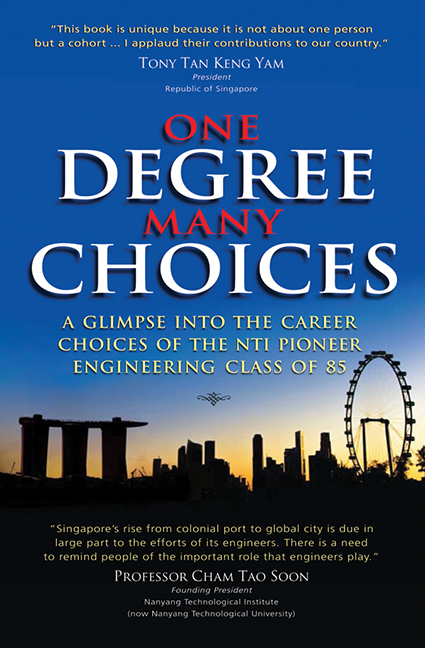 One Degree, Many Choices
One Degree, Many Choices Book contents
- Frontmatter
- Contents
- WHAT THIS BOOK IS ABOUT
- FOREWORD
- ACKNOWLEDGEMENTS
- INTRODUCTION It's All About Life Choices
- PART I THE BEGINING
- PART II ENGINEERING PURSUITS
- CHAPTER 4 Riding High on Semiconductors
- CHAPTER 5 Thriving in the Chemical Industry
- CHAPTER 6 Navigating the Marine Industry
- CHAPTER 7 Rise & Decline of the Disk Drive Industry
- CHAPTER 8 Boom & Bust in the Electronics Industry
- CHAPTER 9 Leading Lights in the IT Industry
- CHAPTER 10 Riding the Ups & Downs in the Telecommunications Industry
- CHAPTER 11 Transporting the Masses
- CHAPTER 12 Providing Electricity & Gas to Singaporeans
- CHAPTER 13 Environment Engineering & Inventions
- CHAPTER 14 Building Infrastructure & Housing Millions
- CHAPTER 15 Building Jewels In & Out of Singapore
- CHAPTER 16 Soaring in Aerospace
- CHAPTER 17 Banking on the Emerging Life Sciences Industry
- CHAPTER 18 Making Waves in Other Industries
- CHAPTER 19 Growing Singapore Inc through Government-Linked Companies
- CHAPTER 20 Defending Our Nation
- CHAPTER 21 Moulding Future Leaders
- CHAPTER 22 Training Engineers at the Frontline
- CHAPTER 23 The CSE Entrepreneurs
- CHAPTER 24 Technopreneurs from EEE
- CHAPTER 25 MPE Graduates Who Became Their Own Boss
- PART III THE LADY ENGINEERS
- PART IV NON-ENGINEERING PURSUITS
- PART V EPILOGUE
- APPENDICES
- THE SUPPORT TEAM
CHAPTER 13 - Environment Engineering & Inventions
from PART II - ENGINEERING PURSUITS
Published online by Cambridge University Press: 21 October 2015
- Frontmatter
- Contents
- WHAT THIS BOOK IS ABOUT
- FOREWORD
- ACKNOWLEDGEMENTS
- INTRODUCTION It's All About Life Choices
- PART I THE BEGINING
- PART II ENGINEERING PURSUITS
- CHAPTER 4 Riding High on Semiconductors
- CHAPTER 5 Thriving in the Chemical Industry
- CHAPTER 6 Navigating the Marine Industry
- CHAPTER 7 Rise & Decline of the Disk Drive Industry
- CHAPTER 8 Boom & Bust in the Electronics Industry
- CHAPTER 9 Leading Lights in the IT Industry
- CHAPTER 10 Riding the Ups & Downs in the Telecommunications Industry
- CHAPTER 11 Transporting the Masses
- CHAPTER 12 Providing Electricity & Gas to Singaporeans
- CHAPTER 13 Environment Engineering & Inventions
- CHAPTER 14 Building Infrastructure & Housing Millions
- CHAPTER 15 Building Jewels In & Out of Singapore
- CHAPTER 16 Soaring in Aerospace
- CHAPTER 17 Banking on the Emerging Life Sciences Industry
- CHAPTER 18 Making Waves in Other Industries
- CHAPTER 19 Growing Singapore Inc through Government-Linked Companies
- CHAPTER 20 Defending Our Nation
- CHAPTER 21 Moulding Future Leaders
- CHAPTER 22 Training Engineers at the Frontline
- CHAPTER 23 The CSE Entrepreneurs
- CHAPTER 24 Technopreneurs from EEE
- CHAPTER 25 MPE Graduates Who Became Their Own Boss
- PART III THE LADY ENGINEERS
- PART IV NON-ENGINEERING PURSUITS
- PART V EPILOGUE
- APPENDICES
- THE SUPPORT TEAM
Summary
“Our knowledge of thermodynamics and fluid mechanics was useful when it came to boilers and turbines.”
— Martinn Ho Yuen Liung, MPE PioneerTHE STENCH WAS OVERPOWERING and Martinn Ho Yuen Liung felt like vomiting. Fresh out of NTI, he had just started work at the Ulu Pandan refuse incineration plant. There was a mechanical failure and the giant travelling crane could not clear the garbage. His mechanical engineering training came to the rescue. “My knowledge of automation technology came in handy,” said Martinn. The fault was a worn-out limit switch. He solved the problem and enabled the refuse trucks to unload the refuse speedily.
Joining Martinn at the Ministry of Environment were Beck Choon Hueei, Lee Kheng Seng, Ong Chin Soon, Pang Fook Chong and Tan Kong Seng. They cut their teeth as shift engineers at the Ulu Pandan plant. With a team of technical personnel under them, they were responsible for the operation and maintenance of the entire incineration cum power generation plant. Under their care were auxiliary equipment such as instrumentation equipment, water treatment plants, pollution control equipment, air conditioning plants, conveyor systems and elevators. Their work required them to innovate to solve engineering problems. Martinn said, “NTI taught us thermodynamics and fluid mechanics. That enabled us to understand the way boilers and turbines work.”
Due to land shortage, incineration is the most viable form of waste disposal in Singapore. The process produces superheated steam to generate electricity, which in turn is used to operate the plant. Excess electricity is sold to the public utility network to generate income.
The NTI pioneers know all the waste disposal facilities in Singapore well. When the Tuas Incineration Plant opened in 1986, it used modern equipment and automation. Ong Chin Soon and Pang Fook Chong worked there. Tan Kong Seng is currently the General Manager at the plant. In 1992, the Senoko Incineration Plant was commissioned. Chin Soon helped to set it up. The latest plant is the Tuas South Incineration Plant which began operations in 2000. Fook Chong is the Senior Manager there. After the first incineration plant at Ulu Pandan was shut down in 2009 and the government divested Senoko plant in a sale to Keppel Group, Chin Soon moved to the Tuas Marine Transfer Station as Senior Manager. This station is the collection point for ash from waste-to-energy plants and non-incinerable waste.
- Type
- Chapter
- Information
- One Degree, Many ChoicesA Glimpse into the Career Choices of the NTI Pioneer Engineering Class of 85, pp. 59 - 62Publisher: ISEAS–Yusof Ishak InstitutePrint publication year: 2012


